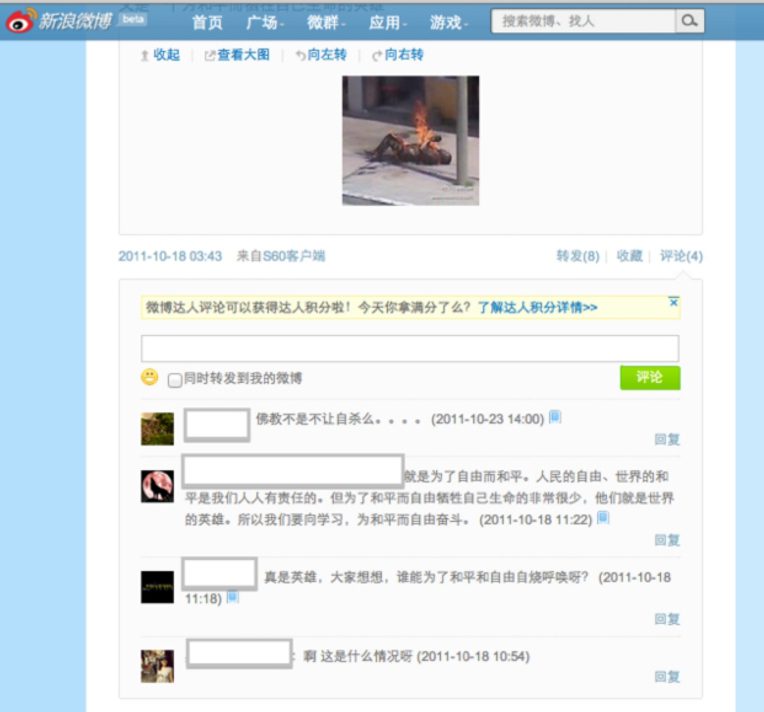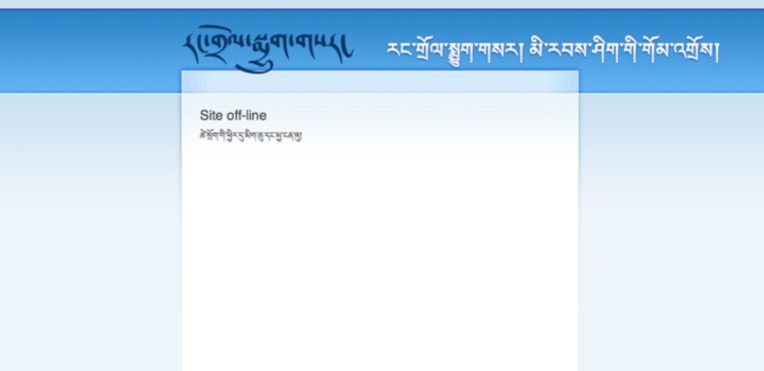Mourning Online
From the Series: Self-Immolation as Protest in Tibet
From the Series: Self-Immolation as Protest in Tibet
Due to restrictive internet controls inside China’s “Great Firewall,” the unprecedented wave of self-immolations inside Tibet that started in 2009 have not been well documented online. Nonetheless, Tibetans inside the People’s Republic of China have found some ways to document and comment on the self-immolations.
A crucial source of information for those of us outside of China is the Chinese-language blog “Invisible Tibet” by well-known writer Tsering Woeser (commonly known by one name, Woeser).[1] Using sources available in the mainstream media and also social media, Woeser writes extensively on the self-immolations and reports on them case by case on her blog. Yet as with Facebook and Twitter, her blog is inaccessible within China. Ordinary Tibetan netizens do not (easily) have access to it or to any online information regarding the self-immolations. In addition, the Chinese government swiftly acts to restrict information that does appear online.
For example, the following screenshot shows how a search on the Chinese microblogging site Weibo for ‘self-immolation,’ 自焚 zìfén, yields no results "due to relevant laws."

This screenshot was taken on 19 October 2011, following a three week period in which seven Tibetans had self-immolated. The first immolation of 2011 was the monk Phuntsog’s self-immolation on 16 March, then Tsewang Norbu on 15 August, followed by a great increase from 26 September through 17 October: Lobsang Kunchok and Lobsang Kelsang on 26 September, then Kelsang Wangchuk, Kayang, Choepel, Norbu Damdrul and Tenzin Wangmo from 3 October through to 17 October.[2]
During this time, the Chinese term for self-immolation was filtered and censored, but the Tibetan term was not. Tibetans writing on Tibetan-language blogs were boldly and directly referring to self-immolations through poetry and prose pieces. On the UK-based High Peaks Pure Earth website, we translated into English two Tibetan poems written in October 2011: the poem “Mourning” posted on the Tibetan language blog Sangdhor.com on 11 October [3], and “The Truth of Flames on the Thorny Path” posted on the Rangdrol site on 25 October.[4] Both poems evoke the imagery of fire and flames. “The Truth of Flames on the Thorny Path” is dedicated to detained Tibetan author Choepa Lugyal whose pen name “Me Che” literally means “tongue of flames,” but can also mean a small smoldering fire or amber. In “Mourning,” the author writes poignantly:
The sadness of living is more painful than death
Unbearable sorrow turned you all into glowing red skeletons
The mouth quivers with flames
The hands are pierced with flames
Flames burn in the breast
Rosary beads of fire scatter to the ground
The emphasis on sorrow, flames, the human body and rosary beads (an unmistakable indicator of faith), all call to mind the self-immolations by monks and nuns and another line in the poem strikes an ominous note of more to come, “After a storm bursts on one grassland / Another storm bursts on the other grassland.”
The overwhelming sentiment of netizens’ comments on the poems is one of respect for the self-immolators. A 12 October comment on “Mourning” says “The light which is set on by the lives of the two heroes will shine their way and I believe the truth will eventually prevail.” The “two heroes” here could be a direct reference to Kayang and Choephel, two young former monks of Kirti Monastery, who self-immolated together on 7 October and both later died in hospital.
By 1 February 2012, the websites Sangdhor and Rangdrol were both inaccessible.[5]
Surprisingly, visual documentation of the self-immolators is to be found on Weibo.[6] The following screenshot shows a photo of a self-immolation uploaded to Weibo on 18 October and re-posted with only the Buddhist mantra Om Mani Padme Hum written in Tibetan. In Chinese, the original poster captioned the photo: “Another hero who sacrifices their life for peace.”[7]

The glorification of the self-immolators is also evident in the following comments taken from Weibo [8]:

However, one voice speaks against self-immolation. In the comments on “Mourning,” a blogger named “Mindrug” says: “I want to express my great respect to both the dead and living heroes. In the meantime, I want to say that the body, the base of the mind, should not be offered as a butter-lamp offering. If we were able to keep our language alive, protect the land of our father and house of our mother, the sky would turn into blue and the sun would rise from behind the clouds again.”
In the discussions, debates and commentaries about the self-immolations, it is very often the voices of the Tibetans who self-immolate that are missing. Apart from some eyewitness accounts, the only testimony to date from a self-immolator as to their thoughts and motivation leading to their act of self-immolation has come from Lama Sobha from Golog in Amdo. Lama Sobha self-immolated on 8 January 2012 and died on the same day. His nine-minute audio testimony was discovered wrapped in his robe and was acquired by Radio Free Asia (based in USA) and Voice of Tibet (based in Norway and India), both of which broadcast directly into Tibet. In his testimony, Lama Sobha addresses Tibetans both inside and outside Tibet and says, “I am giving away my body as an offering of light to chase away the darkness.” He acknowledged those before him who self-immolated: “All the Tibetan heroes too have sacrificed their lives with similar principles. But in practical terms, their lives seemingly ended with some sort of anger. Therefore, to guide their souls on the path to enlightenment, I offer prayers that may lead all of them to Buddhahood.”[9] With the lack of testimonies from the self-immolators, the absence of independent media in Tibet, no foreign diplomatic presence and no outside visitors, the scarce material that can be found on social media by Tibetans is a hint as to the attitudes felt towards the self-immolations by the people affected on the ground.
Lama Sobha’s testimony managed to find its way abroad despite strict controls on the areas rocked by self-immolations. Chinese state media reported that following unrest in Serthar on 24 January 2012, “Internet connections and mobile phone signals were cut off for over 50 kilometers around the riot areas.”[10] Therefore, at a time when individual Tibetans are choosing to make statements using their bodies rather than words, the overwhelming sentiment of sorrow felt by Tibetan netizens is perhaps best summed up in an understated way by the administrators of the site Rangdrol.net. In a move that suggests self-censorship, for the period when the site was offline,[11] an almost blank screen simply said in Tibetan, “For the sake of life, we are mourning and crying.”

27 March 2012
[1] The URL for Woeser’s blog “看不见的西藏” - Invisible Tibet” is http://woeser.middle-way.net/ and it is written in Chinese.
[2] The term 自焚 zìfén was blocked from Weibo for a substantial period of time but at the time of writing (February 28, 2012), the term had since been unblocked. However, search results yielded were not Tibet-related.
[3] Translation of “Mourning” on High Peaks Pure Earth: http://highpeakspureearth.com/2011/mourning-a-poem-about-the-self-immolations/ [last accessed February 28, 2012]
[4] Translation of “The Truth of Flames on the Thorny Path”” on High Peaks Pure Earth:http://highpeakspureearth.com/2011/poem-the-truth-of-flames-on-the-thorny-path/ [last accessed February 28, 2012]
[5] See http://globalvoicesonline.org/2012/02/01/china-several-tibetan-language-blogsites-shut-down/[last accessed February 28, 2012] At the time of writing, February 28, 2012, Rangdrol was back online.
[6] The screenshots in this article taken from Weibo have been edited so that the Weibo names of Tibetans are not visible.
[7] NB This post on Weibo was still accessible on February 25, 2012.
[8] Photo uploaded onto Weibo on October 18, 2011, still accessible on February 25, 2012
[9] Lama Sobha’s story and testimony taken from a report by International Campaign for Tibet, 1 February 2012 http://savetibet.org/media-center/ict-news-reports/harrowing-images-and-last-message-tibet-first-lama-self-immolate [last accessed March 24, 2012]
[10] “Monks Run Amok”, “Global Times”, 3 February 2012 http://www.globaltimes.cn/NEWS/tabid/99/ID/694406/Monks-run-amok.aspx [last accessed 24 March 2012]
[11] See Global Voices, “China: Several Tibetan Language Blog Sites Shut Down”, 1 February 2012, http://globalvoicesonline.org/2012/02/01/china-several-tibetan-language-blogsites-shut-down/ [last accessed 24 March 2012]
Dechen Pemba, Editor, HighPeaksPureEarth.com